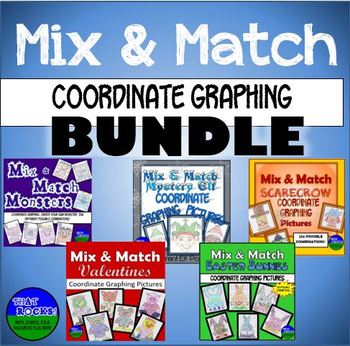Mix and Match Coordinate Graphing Pictures Bundle
That Rocks Math Science and ELA
2.2k Followers
Grade Levels
5th - 8th
Subjects
Resource Type
Standards
CCSS5.G.A.1
CCSS5.G.A.2
Formats Included
- Zip
Pages
36+
That Rocks Math Science and ELA
2.2k Followers
What educators are saying
This was great for early finishers, students working in small groups, and for students who wanted extra work at home.
Products in this Bundle (5)
Description
You can have all our Mix and Match Coordinate Graphing Bundles for a discounted price! This purchase also entitles you to all future Mix and Match Coordinate Graphing activities that we add to the bundle, at no additional cost! These graphing pictures are perfect for Halloween (monsters), Thanksgiving (scarecrows), Christmas (elves), Valentine's Day (different animals with heart messages), and Easter (bunnies).
These files in total allow your students to create 832 different pictures (256 from 3 packets and 64 from the fourth)! Add in coloring and personal touches, and your students will have very unique graphs! The completed pictures make a great bulletin board display!
Total Pages
36+
Answer Key
Included
Teaching Duration
N/A
Last updated Jan 31st, 2019
Report this resource to TPT
Reported resources will be reviewed by our team. Report this resource to let us know if this resource violates TPT’s content guidelines.
Standards
to see state-specific standards (only available in the US).
CCSS5.G.A.1
Use a pair of perpendicular number lines, called axes, to define a coordinate system, with the intersection of the lines (the origin) arranged to coincide with the 0 on each line and a given point in the plane located by using an ordered pair of numbers, called its coordinates. Understand that the first number indicates how far to travel from the origin in the direction of one axis, and the second number indicates how far to travel in the direction of the second axis, with the convention that the names of the two axes and the coordinates correspond (e.g., 𝘹-axis and 𝘹-coordinate, 𝘺-axis and 𝘺-coordinate).
CCSS5.G.A.2
Represent real world and mathematical problems by graphing points in the first quadrant of the coordinate plane, and interpret coordinate values of points in the context of the situation.





